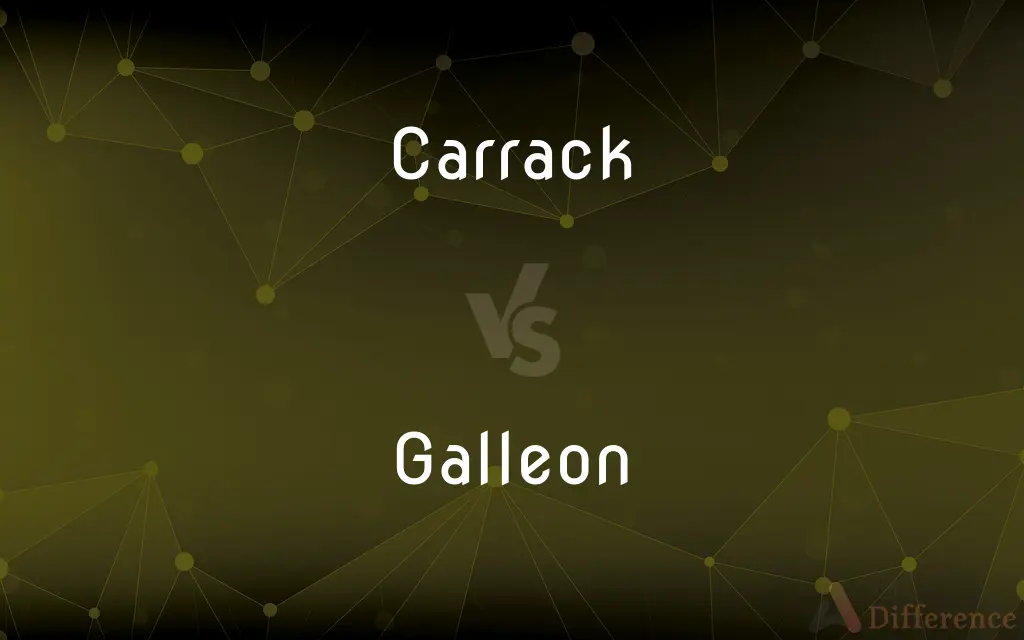Carrack vs. Galleon — What's the Difference?
By Tayyaba Rehman & Maham Liaqat — Updated on March 22, 2024
Carracks are ocean-going ships of the 14th to 17th centuries, notable for their large size and rounded sterns, while galleons, developed later, were faster, sleeker, and designed for long voyages and battles.

Difference Between Carrack and Galleon
Table of Contents
ADVERTISEMENT
Key Differences
Carracks were among the first ships used for oceanic exploration, designed with a broad beam and a high rounded stern, making them stable in heavy seas. Whereas, galleons emerged in the 16th century as a response to the need for faster, more maneuverable ships that could carry more cargo and were better suited for naval warfare.
Carracks typically featured three to four masts with square sails on the foremast and mainmast, and lateen sails on the mizzenmast to improve maneuverability. On the other hand, galleons were designed with a lower profile, featuring square sails on most masts and a lateen sail on the last mast, which enhanced their speed and agility at sea.
The carrack's design was heavily influenced by the nao, which it evolved from, focusing on capacity and durability for long voyages. In contrast, the galleon was a result of combining the best features of the carrack and the caravel, focusing on speed, firepower, and capacity, marking a significant evolution in naval architecture.
Carracks were widely used by European nations for trade, exploration, and military purposes, becoming synonymous with the Age of Discovery. Galleons, however, played a pivotal role in the Spanish Treasure Fleet, defending the Spanish Empire's wealth from pirates and other European powers, signifying their strategic importance in naval history.
While the carrack was more rounded and bulky, making it somewhat less efficient in terms of speed but excellent for carrying large amounts of cargo, the galleon’s sleeker design and improved rigging system allowed it to carry substantial cargo while also being capable of engaging effectively in naval battles.
ADVERTISEMENT
Comparison Chart
Era
14th to 17th centuries
16th to 18th centuries
Design Purpose
Exploration, trade, and transport
Warfare, treasure fleets, and trade
Hull Design
Rounded, high stern, bulky
Sleeker, lower profile, more streamlined
Mast and Sails
Three to four masts, square and lateen sails
Mostly square sails, with lateen on the last mast
Role in History
Pioneered oceanic exploration
Dominated naval warfare, protected treasure fleets
Compare with Definitions
Carrack
Featured a rounded stern and high castles at the bow and stern.
The carrack's distinctive silhouette was easily recognizable on the horizon.
Galleon
Characterized by its sleek design and extensive use in naval battles.
Galleons played a crucial role in defending Spain's overseas empire.
Carrack
Primarily utilized by European nations for exploration and trade.
Portugal's carracks opened sea routes to India, transforming global trade.
Galleon
A symbol of maritime dominance and the treasure fleet.
Galleons carried silver and gold from the Americas to Spain, enriching the empire.
Carrack
A large, ocean-going ship used from the 14th to the 17th centuries, designed for long voyages.
The carrack navigated the globe, proving essential for early explorers.
Galleon
Featured advanced rigging and sail designs for better maneuverability.
The galleon’s design allowed it to outrun and outmaneuver pirates.
Carrack
Could carry significant cargo, making it vital for the Age of Discovery.
The carrack returned laden with spices and silks from the East.
Galleon
A large sailing ship used from the 16th to the 18th centuries, optimized for speed and armament.
The Spanish galleon was feared for its firepower and speed.
Carrack
Evolved from earlier ship designs like the nao.
The carrack represented an evolution in ship design, improving on the nao's capabilities.
Galleon
Resulted from combining features of carracks and caravels.
The galleon’s innovative design was a testament to centuries of naval evolution.
Carrack
A carrack (Portuguese: nau, Spanish: nao, Catalan: carraca) is a three- or four-masted ocean-going sailing ship that was developed in the 14th to 15th centuries in Europe, most notably in Portugal. Evolved from the single-masted cog, the carrack was first used for European trade from the Mediterranean to the Baltic and quickly found use with the newly found wealth of the trade between Europe and Africa and then the trans-Atlantic trade with the Americas.
Galleon
Galleons were large, multi-decked sailing ships first used as armed cargo carriers by European states from the 16th to 18th centuries during the age of sail and were the principal vessels drafted for use as warships until the Anglo-Dutch Wars of the mid-1600s. Galleons generally carried three or more masts with a lateen fore-and-aft rig on the rear masts, were carvel built with a prominent squared off raised stern, and used square-rigged sail plans on their fore-mast and main-masts.
Carrack
A large sailing vessel with a high forecastle and poop, used from the 1300s to the 1500s.
Galleon
A sailing ship in use (especially by Spain) from the 15th to the 18th centuries, originally as a warship, later for trade. Galleons were typically square-rigged and had three or more decks and masts
A Spanish treasure galleon wrecked off the Florida Keys
Carrack
(historical) A large European sailing vessel of the 14th to 17th centuries similar to a caravel but square-rigged on the foremast and mainmast and lateen-rigged on the mizzenmast.
Galleon
A large three-masted sailing ship with a square rig and usually two or more decks, used in the 1500s, 1600s, and 1700s, especially by Spain as a merchant ship or warship.
Carrack
See Carack.
Galleon
A large, three masted, square rigged sailing ship with at least two decks.
Carrack
A large galleon sailed in the Mediterranean as a merchantman
Galleon
A sailing vessel of the 15th and following centuries, often having three or four decks, and used for war or commerce. The term is often rather indiscriminately applied to any large sailing vessel.
The galleons . . . were huge, round-stemmed, clumsy vessels, with bulwarks three or four feet thick, and built up at stem and stern, like castles.
Galleon
A large square-rigged sailing ship with three or more masts; used by the Spanish for commerce and war from the 15th to 18th centuries
Common Curiosities
What is a carrack?
A carrack is a large, ocean-going ship used primarily for exploration, trade, and transport from the 14th to the 17th centuries.
What distinguishes a galleon from a carrack?
A galleon is sleeker, faster, and more heavily armed than a carrack, designed for naval warfare and protecting treasure fleets.
What was the main use of carracks?
Carracks were primarily used for exploration, trade, and transporting goods across vast oceans.
Why were carracks important?
Carracks were crucial for early oceanic exploration and global trade, opening up new routes and markets.
How did galleons improve upon the design of carracks?
Galleons featured a more streamlined design and better sail configuration, improving speed and maneuverability for naval battles.
What role did galleons play in history?
Galleons played a pivotal role in naval warfare, protecting treasure fleets, and establishing maritime empires.
Where were carracks primarily built?
Carracks were built in various European countries, with Portugal and Spain being notable builders.
What innovations did galleons introduce?
Galleons introduced innovations in hull design, rigging, and armament, setting new standards for naval ships.
In what ways were galleons used?
Galleons were used in naval warfare, as part of treasure fleets, and for long-distance trade.
What were the sailing capabilities of carracks?
Carracks had good stability and could carry ample cargo, but were not the fastest ships.
How did galleons’ sailing capabilities compare to carracks?
Galleons were faster and more agile, with improved sail designs for better maneuverability.
Are any original carracks or galleons preserved today?
Very few original carracks or galleons are preserved today, with most information about them coming from historical records, drawings, and archaeological findings.
How did the design of carracks influence future ships?
Carracks influenced future ship designs with their sturdy construction and capacity for carrying large cargoes.
Why did the use of carracks decline?
The use of carracks declined as ship designs evolved towards faster, more maneuverable, and more heavily armed ships like galleons.
How did the advent of the galleon affect naval warfare?
The advent of the galleon significantly impacted naval warfare, with its speed and firepower making it a dominant force on the seas.
Share Your Discovery

Previous Comparison
Mongoose vs. Civet
Next Comparison
Diagram vs. GraphAuthor Spotlight
Written by
Tayyaba RehmanTayyaba Rehman is a distinguished writer, currently serving as a primary contributor to askdifference.com. As a researcher in semantics and etymology, Tayyaba's passion for the complexity of languages and their distinctions has found a perfect home on the platform. Tayyaba delves into the intricacies of language, distinguishing between commonly confused words and phrases, thereby providing clarity for readers worldwide.
Co-written by
Maham Liaqat













































